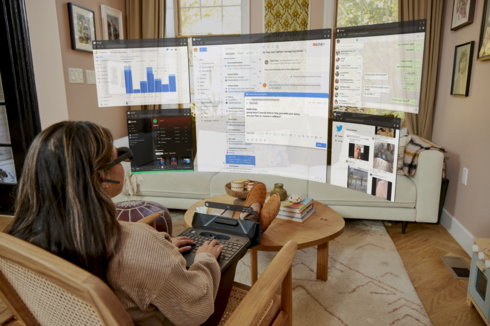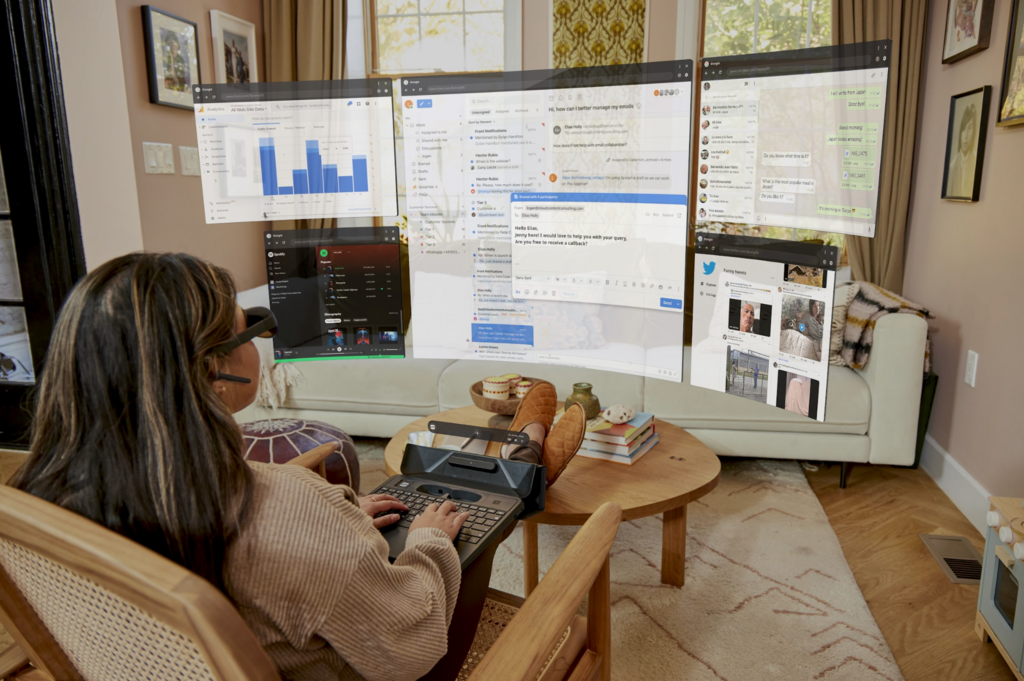
Israel's Sightful reveals its revolutionary AR laptop Spacetop
The startup's new laptop has no physical screen and comes instead with augmented reality (AR) glasses
Israeli startup Sightful has finally revealed its product that has been shrouded in mystery since 2020: Spacetop, a laptop with no physical screen that comes instead with augmented reality (AR) glasses. Save for the lack of a screen, Spacetop looks like a regular 13-inch laptop. However, with an option of opening multiple screens at the same time, the company says it is like having a 100-inch laptop in your backpack. It comes with relatively small glasses, costs $2,000 and is currently only available in the U.S., where all regulatory approvals have been received.
Sightful is registered in Israel and employs 60 people in its Tel Aviv office. To date, the company has raised $61 million over two rounds, the last of which was completed at the beginning of the year, in which it raised $33 million led by Corner Ventures. The company raised $28 million in its Seed round led by Michael Eisenberg and Eden Shochat's Aleph VC.
Sightful is headed by CEO and Co-founder Tamir Berliner, who was one of the founders of PrimeSense, one of the Israeli companies behind the successful Xbox Kinect. PrimeSense was later bought by Apple for $350 million, and was utilized for the iPhone’s facial recognition technology.
After the sale to Apple, Berliner served as the General Manager at Magic Leap Israel which developed AR glasses. Since its founding in 2010, Magic Leap has raised a whopping $3.5 billion. Berliner left the company along with Tomer Kahan (COO) to found Sightful in 2020.
Calcalist spoke with the two founders ahead of Thursday's announcement and they shared some of the lessons they learned from Magic Leap when establishing their own startup.
"Before you develop the product, you need to know who your customer is and build something based on that," says Berliner. "You don't have to throw a lot of things at the user and say, ‘decide what you want to do with it.’ First we knew why we wanted to build the product and why it was needed, and only after that we developed the technology that made it possible."
Berliner points to the fact that Magic Leap glasses were not a commercial success because they were very expensive and cumbersome. Spacetop comes with smaller glasses, almost the size of regular eyeglasses, that are attached to the laptop. Those who need glasses can include their prescription when ordering the laptop and receive special lenses that are magnetized to the augmented reality glasses. Users must wear the glasses to access the computer screen, which also protects privacy when working in shared spaces or in cafes.
The laptop is manufactured at the Wistron factory in Taiwan, where about a tenth of all laptops in the world are manufactured today, including Lenovo, Dell and HP.
"When we left Magic Leap to start a company, we left with the knowledge that the world of AR had reached maturity, but we didn't have the final idea," continues Berliner. "Then Covid-19 began and we saw the transformation in the labor market, when people needed to be productive everywhere, but at the same time work now requires more and more screens and applications at any given moment. This is exactly the type of contradiction that can be solved using AR. The thing is that until now no one has produced AR products, and there wasn't something that was really suitable for everyday use. We don't see ourselves as an AR company, but as a product company."
The founders said that they are only selling 1,000 units at this stage in order to receive user feedback and improve the product before moving to mass production. "It is clear to us that this is a new category. The laptop has barely changed since it came into mass use about two decades ago. Our approach is to cooperate with the leading companies," says Berliner. "If the big players want to cooperate, we will be happy to. At this point the goal is to understand what the users need and make the best version of the product. This is the beginning of a revolution."














